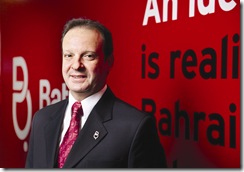In the five years that Peter Kaliaropoulos has been CEO of Batelco, he has transformed the incumbent telco from a single country operator with fewer than 400,000 mobile subscribers to a seven-country operation with 7.3 million users. The telco’s ambitions don’t end there: with a strategic aim to operate in 12-15 different territories counting 15-20 million subscribers within five years; Kaliaropoulos is growing the company in a fashion never experienced by a Gulf operator before
Peter Kaliaropoulos has been CEO of Batelco since March 2005. A native of Australia, he has around 25 years experience in the telecom sector, most of it spent in the Asia Pacific region
Describing Batelco Group as a ‘boutique’ operator appears to take the weight of expectation off the shoulders of its plain-talking CEO, Peter Kaliaropoulos. Over the past five years the telecom sector in the Gulf region has been characterised by lavish spending that has turned regional operators into multi-territory behemoths overnight. The label ‘boutique’ seems to help Batelco separate itself from the league of operators that have grown explosively in recent years, placing it in a niche that no other player from the region quite occupies.
“We do believe in scale, but we need to find it at the right price to acquire it,” Kaliaropoulos told Comm. “Scale and diversification into new geographies is very important. I think some other companies were bolder but they paid a lot of money for licences in other countries. For us it is more steady steps rather than big jumps and US$3-4 billion acquisitions.”
Any example of Batelco’s ‘steady steps’ approach to expansion is India where it effectively paid US$175 million for 49 per cent in S-Tel, and mobile operator with licences covering six of India’s 22 telecom circles, with a combined population of 230 million. Batelco’s investment into India came at a time when the UAE’s Etisalat paid US$900 million for a 45 per cent stake in Swan Telecom, Norway’s Telenor paid US$1.07 billion for 60 per cent of Unitech Wireless, and Japan’s NTT DoCoMo acquired a 26 per cent stake of Tata Teleservices for US$2.7 billion.
“We spent about 18 months looking for the right opportunities (in India) and from day one, the more opportunities we looked at it reinforced our view, we did not want to be a national operator,” Kaliaropoulos explained. “(Bidding on and rolling out a national network) was an absolute formula to lose money. We wanted to find pockets where the penetration is not very high, try and get some licences in those few circles, and build a business without having to invest a minimum of US$2.5 billion CAPEX on the network before having a single customer.”
Kaliaropoulos assumed the same pragmatic approach during the long-delayed auction of 3G licences that occurred in India earlier this year, with Batelco being awarded spectrum in three circles for a little over US$72 million.
“There’s a five-year commitment before you have to roll out a 3G network, so we are looking at how to roll it out, and maybe minimise some of (our) 2G CAPEX and go to 3G,” Kaliaropoulos said. “But in some of those circles 3G smartphones, for example, are not widely available so we are not going to rush and introduce a new technology if the customer is not ready for it.”
With respect to S-Tel’s 2G operation, in April the operator announced it had added over one million subscribers in its first 90 days of commercial operation, with subscribers numbering 1.33 million as of the end of June. Kaliaropoulos is under no illusions with respect to the amount of investment required in India to make a success of Batelco’s relatively light presence there, despite the pragmatic course the investment has begun on.
Kaliaropoulos forecasts that S-Tel will reach break even after four years, and that prior to that time there will need to be a firm commitment from shareholders in supporting the growth and development of the venture.
“The challenge with India is that in the short-term, as you’re spending cash to build infrastructure you need to be funding that. The mid-to-long-term prospects are very positive, though in the short-term you are going to have to burn some cash and report losses on your P&L,” Kaliaropoulos commented.
One of the biggest challenges faced by operators in India is that the customers entering the market have very low ARPU – US$1.50 – US$2, necessitating operating models to be streamlined and CAPEX to be considered under different business models. Infrastructure sharing initiatives in the country are assisting in the arrest of CAPEX to a degree, making some of the cost variable, though the underlying premise of making money in an extremely competitive market remains.
“In terms of customer acquisition in India we are fairly positive and in terms of revenue flows we are fairly positive. But India is marathon; anybody who thinks it’s a sprint sets himself up for disappointment. You really have to believe in the fundamentals of the country,” Kaliaropoulos asserted.
The effects of that ‘Indian marathon’ are being felt in Batelco’s financial results, reporting a year-on-year fall in profitability. The telco attributed the 20 per cent decline in net profits in Q210 to increasing competition in its domestic market, as well as growing start-up costs for S-Tel.
Net profit for the quarter decreased to BHD 22.3 million (US$59.2 million) from BHD 27.9 million a year earlier, while revenues tightened by 2.4 per cent to stand at BHD 84.8 million.
Batelco’s mobile customer base in Bahrain grew by 16 per cent in H110 to 869,000 and its fixed and wireless broadband services grew by eight per cent to 88,000 accounts. Fixed lines continued to decline and stood at 192,000 end-June, a five per cent decline year-on-year
“Gross revenues did not grow in the first-half predominantly due to the entry of the third mobile operator in the Bahrain market,” Batelco Group chairman Shaikh Hamad Bin Abdulla Al Khalifa said in a statement, referring to the entry in March of Viva Bahrain, a subsidiary of Saudi’s STC. Zain is the second mobile provider in the country.
“Reduced market share for mobile and broadband services and strong price erosion adversely affected our revenues and profits,” he added.
Overall active Batelco Group mobile subscribers surged 47 per cent during H110 to reach 6.88 million, while broadband Internet users increased 54 per cent over the period to 230,600.
Batelco had informed the market in February that it expected a reduction in profits for 2010 due to the nature of its ongoing operations and despite the impact felt by the launch of Viva on March 3, Kaliaropoulos is generally satisfied by the incumbent’s overall performance in the face of the latest source of domestic competition.
“The entry of a third operator, if you look at SIM numbers and if that is how the industry classifies market share, Viva has taken market share because people become second or third SIM carriers,” Kaliaropoulos acknowledged. “The market has grown by the entry of Viva; we estimate by between 250,000 – 300,000 additional SIMS (in the second quarter), so we believe the market will be around about 1.8 million – 1.9 million SIMs at the end of June.”
The price erosion being caused by the addition of SIMs and competitors in Bahrain has been one of the fundamental reasons driving the Batelco’s desire to boost its mobile data offering domestically and to seek out new opportunities in other markets, and seems likely to continue.
Kaliaropoulos believes that if anything is going to save the telecom industry it is mobile data. Internet access, Internet applications, and consumers downloading content, are the areas in which Batelco is seeing growth and the telco is actively encouraging subscribers to utilise 3G devices, smartphones and basically download mobile data as much as possible.
Data roaming and international voice roaming also remain growth areas for Batelco and while the telco is not permitted to bundle products across it various product lines, the marketing message to its customer is that the telco is a full service provider.
“We are using customer service to retain and offer a better service to subscribers. Hopefully in the near future we will be able to do bundles like all other companies in the world, but it all comes down to when the regulator decides we are not dominant,” Kaliaropoulos stated.
In the next five years Batelco expects to see 80 per cent of its revenues derived from markets outside of its home market. Today around 32 per cent of revenues are generated from its international operations (India, Jordan, Saudi Arabia, Yemen, Kuwait and Egypt) and Batelco is seeking a complete reversal of that. Kaliaropoulos believing there is no other choice for the telco.
“That has to happen because all the analysis we have conducted says the market in Bahrain will not grow in any shape or form to compensate for potential market share loss from multiple companies coming in,” he said.
“We know this, so for us it is not just growth it is a survival strategy. We are setting ourselves a pretty ambitious target of 80 per cent of our revenues and 50 per cent of profits coming from markets outside Bahrain in five years.”
Profits sourced from overseas operations are always likely to be lower than domestic profits as some of the international plays are start-ups that take 4-5 years to break even.
In order to organise the effort to generate a greater proportion of turnover and profit from abroad, at the end of last year Batelco underwent a rebranding programme that also incorporated the formalisation of the group structure. However, Kaliaropoulos is adamant that the company does not require a single ‘mother brand’ to roll out across its footprint.
“As part of the group strategy we have a very strong view – we do not need a group brand,” he asserted. “I think a uniform brand makes a lot of sense if it is a high value brand or over time if you set up a new company in a new country. However, two things for us; there are not that many new licences around the place, so we tend to be buying into existing companies. They have their own brand and also we tend to be focusing on emerging markets.”
Kaliaropoulos’ view is if one takes the Umniah brand in Jordan, or Sabafon in Yemen, he believes they create a strong brand with the customer for the value-conscious users in those markets. Thus Batelco’s strategy is very explicit, not to create a single brand along the lines that Zain did a few years ago. 
“We also learnt from the Zain experience and the research that we have seen has shown that it is difficult to do this kind of thing successfully; it was an extremely expensive exercise, and customers were lost,” Kaliaropoulos said.
Batelco’s operation in India counted 1.33 million subscribers at the end of June. The operator is looking to build an initial network with a capacity of around seven million
In Batelco’s case the group is there to reinforce the multi brand, local strength, and local perception of its businesses. Kaliaropoulos describes another strategic priority of Batelco’s as wanting to introduce a “smarter business strategy”, facilitating the in-country operations to focus completely on products, customers, collecting cash, running the operations, and best practice. Matters including procurement, technology, planning, finance, and treasury are organised at the group level.
Batelco Group has reiterated that it is interested in acquiring further assets and Kaliaropoulos confirms the company is reviewing some opportunities.
“We don’t want too many start-ups because they are dilutive so we need to make sure we find acquisitions that are accreditive, and we are in discussion with various companies. I believe there is pragmatism entering acquisition discussions, which is good,” he said.
As Batelco continues to forge ahead it is likely to continue to build on a business model that is not at all common in the telecom sector in the Gulf region whereby an operator looks to expand incrementally and without leveraging the business to a large degree in order to achieve it. Value creation for shareholders remains a large component of Kaliaropoulos’ vision for Batelco, both in the short- as well as the long-term.
“In the last five years we have paid out close to US$1 billion in dividends and extra shares. We have invested just over US$800 million in new acquisitions and we have paid down our debt. We have zero debt today; down from about US$500 million a few years ago. So further investment depends on how much you want to leverage the company first of all because you can do more, but we shall move step-by-step, which may take more time,” Kaliaropoulos said.





0 comments ↓
There are no comments yet...Kick things off by filling out the form below.
Leave a Comment